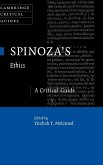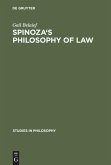Readers of Spinoza's philosophy have often been daunted, and sometimes been enchanted, by the geometrical method which he employs in his philosophical masterpiece the Ethics. In Meaning in Spinoza's Method Aaron Garrett examines this method and suggests that its purpose, in Spinoza's view, was not just to present claims and propositions but also in some sense to change the readers and allow them to look at themselves and the world in a different way. His discussion draws not only on Spinoza's works but also on those of the philosophers who influenced Spinoza most strongly, including Hobbes, Descartes, Maimonides and Gersonides. This original and controversial book will be of interest to historians of philosophy and to anyone interested in the relation between form and content in philosophical works.
Table of contents:
Introduction: 'in more geometrica' - Spinoza's geometrical method; 1. A worm in the blood: some central themes in Spinoza's Ethics; 2. A few further basic concepts; 3. Emendative therapy and the Tractatus de Emendatione Intellectus; 4. Method: analysis and synthesis; 5. Maimonides and Gersonides; 6. Definitions in Spinoza's Ethics: where they come from and what they are for; 7. The third kind of knowledge and 'our' eternity.
This original and controversial book examines the geometrical method employed by Spinoza in his masterpiece the Ethics, and suggests that its purpose, in Spinoza's view, was not just to present claims and propositions but also to allow the readers to look at themselves and the world in a different way.
Garrett argues for the interconnection between Spinoza's method and the content of his philosophy.
Hinweis: Dieser Artikel kann nur an eine deutsche Lieferadresse ausgeliefert werden.
Table of contents:
Introduction: 'in more geometrica' - Spinoza's geometrical method; 1. A worm in the blood: some central themes in Spinoza's Ethics; 2. A few further basic concepts; 3. Emendative therapy and the Tractatus de Emendatione Intellectus; 4. Method: analysis and synthesis; 5. Maimonides and Gersonides; 6. Definitions in Spinoza's Ethics: where they come from and what they are for; 7. The third kind of knowledge and 'our' eternity.
This original and controversial book examines the geometrical method employed by Spinoza in his masterpiece the Ethics, and suggests that its purpose, in Spinoza's view, was not just to present claims and propositions but also to allow the readers to look at themselves and the world in a different way.
Garrett argues for the interconnection between Spinoza's method and the content of his philosophy.
Hinweis: Dieser Artikel kann nur an eine deutsche Lieferadresse ausgeliefert werden.








